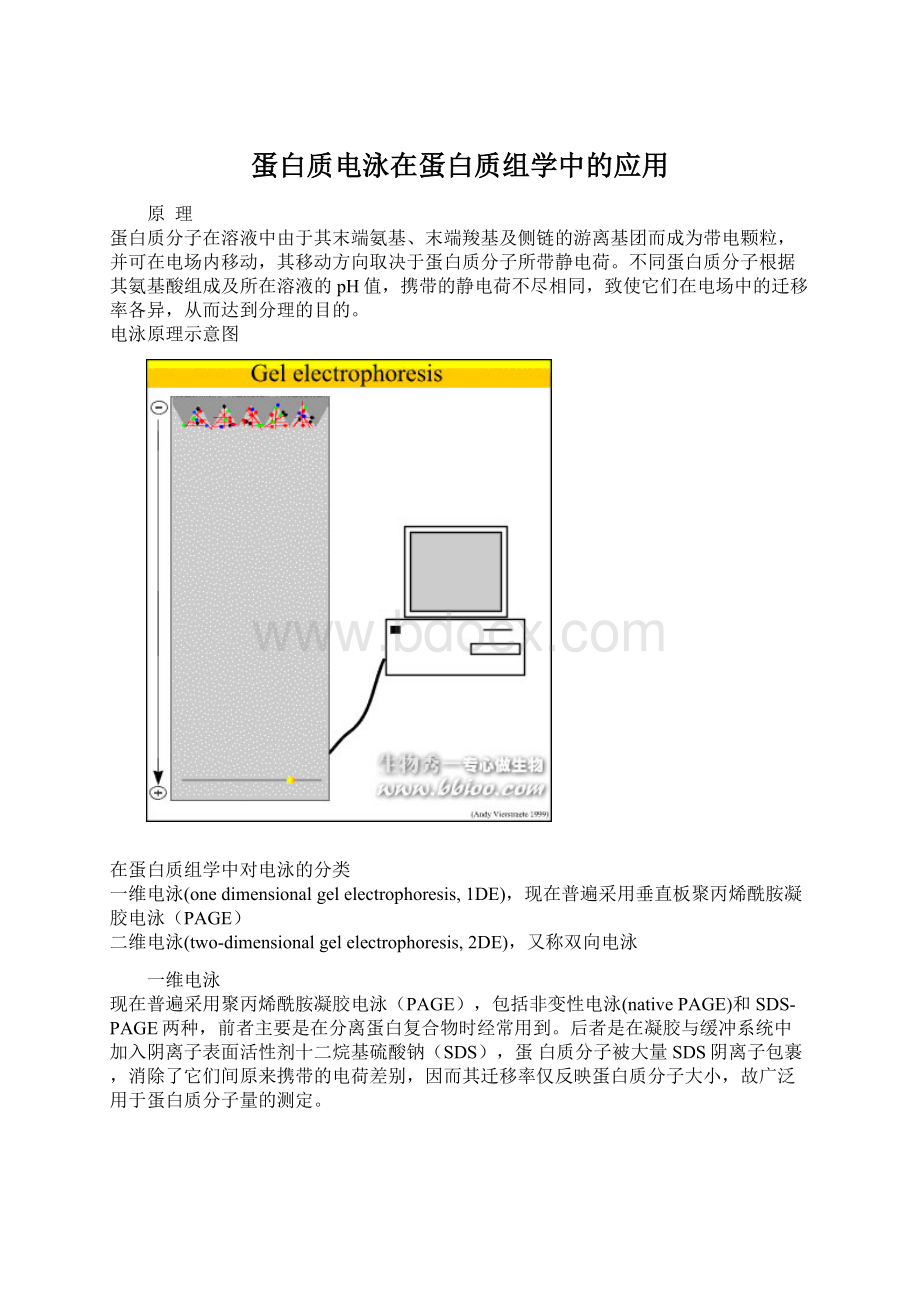蛋白质电泳在蛋白质组学中的应用.docx
《蛋白质电泳在蛋白质组学中的应用.docx》由会员分享,可在线阅读,更多相关《蛋白质电泳在蛋白质组学中的应用.docx(27页珍藏版)》请在冰豆网上搜索。

蛋白质电泳在蛋白质组学中的应用
原 理
蛋白质分子在溶液中由于其末端氨基、末端羧基及侧链的游离基团而成为带电颗粒,并可在电场内移动,其移动方向取决于蛋白质分子所带静电荷。
不同蛋白质分子根据其氨基酸组成及所在溶液的pH值,携带的静电荷不尽相同,致使它们在电场中的迁移率各异,从而达到分理的目的。
电泳原理示意图
在蛋白质组学中对电泳的分类
一维电泳(onedimensionalgelelectrophoresis,1DE),现在普遍采用垂直板聚丙烯酰胺凝胶电泳(PAGE)
二维电泳(two-dimensionalgelelectrophoresis,2DE),又称双向电泳
一维电泳
现在普遍采用聚丙烯酰胺凝胶电泳(PAGE),包括非变性电泳(nativePAGE)和SDS-PAGE两种,前者主要是在分离蛋白复合物时经常用到。
后者是在凝胶与缓冲系统中加入阴离子表面活性剂十二烷基硫酸钠(SDS),蛋白质分子被大量SDS阴离子包裹,消除了它们间原来携带的电荷差别,因而其迁移率仅反映蛋白质分子大小,故广泛用于蛋白质分子量的测定。
凝胶浓度和蛋白质分离范围
缓冲液的选择
通常在SDS-PAGE均选择Tris-glycine作为电泳的缓冲系统。
但在大部分缓冲系统中,SDS微团(micelle)会干扰小分子蛋白质的分离,而Tris-tricine系统则可使小蛋白质-SDS复合物与微团分离,去除干扰。
此外,也证明该系统对脂多糖和脂寡糖混合物的分离有效。
12%胶常用的低分子量标准蛋白
名称
来源
分子量
磷酸化酶B
兔肌肉
97400
牛血清白蛋白
牛
66200
卵清蛋白
鸡蛋清
45000
碳酸酐酶
牛
31000
胰蛋白酶抑制剂
大豆
21500
溶菌酶
鸡蛋清
14400
一维凝胶染色
现在用于凝胶中蛋白染色的方法包括氨基黑10、考马斯亮蓝R250、考马斯亮蓝R350、银染、铜染及橙染(syproorange)。
最常用的为考马斯亮蓝R250、考马斯亮蓝R350染色,为了提高灵明度采用银染。
一维电泳的应用
初步测定蛋白质的分子量
初步分离蛋白质复合物,并进一步用于免疫组化分析
对重组表达蛋白的初步鉴定
将一维电泳和生物质谱相结合,达到对较简单蛋白复合物的分离和鉴定
一维电泳在蛋白质组研究中的应用举例
我们将一维电泳和LC-Ms/MS结合,成功进行如下研究:
(1)血浆蛋白质组研究
(2)SARS病毒蛋白的分析鉴定,成功鉴定了SARS病毒的S蛋白、N蛋白和E蛋白,有力推动了我国第一个SARS疫苗的研究和申报工作。
双向电泳(2DE)
原理:
2DE就是第一向采用等电聚焦分离,第二向为SDS-PAGE分离。
由于2DE是依据蛋白质的两种不同性质,即等电点和分子量进行分析,因此分辨率远高于其他任何一种单一的电泳方法,是目前分析混合蛋白质样品最有效的手段。
(注意:
双向电泳中的“双向”指的是按照蛋白质的两个性质即“等电点和分子量”进行分离的原理。
)
2DE仪器系统
2DE在蛋白质组学方案中所处的位置
这就是将2DE和质谱相结合进行比较蛋白质组分析的实验方案。
(方案完后),下面,我将汇报用以上介绍的方法进行脾淋巴细胞及乳腺癌比较蛋白质组学的实验结果。
双向电泳的操作程序(以进行差别表达蛋白组分析为例)
1.样品制备
2.IPGstrips重泡胀及上样(rehydrationandliading)
3.等电聚焦
4.胶条平衡,包括还原和烷基化
5.第一向胶条转移到第二向
6.SDS-PAGE
7.染色
8.图像分析
目前,普遍采用预制的固定pH梯度胶条(immobilizedpHgradientstrips,IPGstrips)。
商品化的IPGstrips可以从AmershamPharmacia公司或BioRad公司购买。
IPG胶条制备(castingofIPGstrips)
IPGslabgelswithlineargradientspH4-7,4-9,6-10and4-12arecastaccordingtoGörgetal.(1986)withtherecipesofRighetti(1990)andGörgetal.(1998).
Twostartersolutions(anacidiconeandabasicone)arepreparedasdescribedinTable1.Forbetterpolymerization,theacidicandbasicsolutionsareadjustedtopH7withsodiumhydroxideandaceticacid,respectively.
Procedure
Toassemblethepolymerisationcassettewettheplainglassplate(size260x200mm2)withafewdropsofwater.PlacetheGelbondPAGfilm,hydrophilicsideupwards,onthewettedsurfaceoftheplainglassplate.TheGelBondPAGfilmshouldoverlaptheupperedgeoftheglassplatefor1-2mmtofacilitatefillingofthecassette.Expelecxesswaterwitharoller.PlacetheglassplatewhichbearstheU-frame(0.5mmthick)ontopoftheGelBondPAGfilmandclampthecassettetogether.Putitintherefrigeratorfor30min.
Assemblyofthegelcastingcassette
(Left):
AssemblyofthepolymerisationcassetteforIPGandSDSgelcastingonplasticbacking(Glassplates,GelBondPAGfilm,U-frame0.5mmthick)
(Right):
ApplicationoftheGelBondPAGfilmontotheglassplate
IPGgelcasting
(1)Gradientmixerandconnectingvalve;
(2)outlettubingvalve;(3)gelcastingcassette
Theacidic,densesolutionispipettedintothemixingchamberandthebasic,lightsolutionintothereservoirofthegradientmixer,anextraportionofthedensesolutionispreparedandpipettedintothemoldpriortopouringthegradient.
Afterpouringthegradientintotheprecooledmold(refrigerator),themoldiskeptatroomtemperaturefor15mintoallowadequatelevellingofthedensitygradientpriortopolymerizationforonehourat50°C.Afterpolymerization,themoldiskeptatroomtemperatureforatleast15min.ThentheIPGgelisremovedfromthemoldandextensivelywashedwithdeionizedwater,impregnatedwith2%glycerol,anddriedatroomtemperatureinadust-freecabinetand,ifnotusedimmediately,coveredwithaplasticfilmforstorageat-20°C.Thedriedgelscanbestoredfrozenforatleastoneyear.
Note:
InordertoensurethereproducibilityoftheIPGgradient,thevolumeofthecassetteshouldbeconstant.Therefore,itisrecommendedtocheckthevolumeofthecassettefromtimetotimesinceitdiminishesonageingoftheU-frame.
Note:
Whenoneofthechambersisemptyingfasterthantheother,theresultingpHgradientwillnotbelinear.Checkifthereisanairbubbleintheconnectinglineorwhetherthespeedofthemagneticstirrerisnotappropriate!
1.样品制备
样品裂解液(lysissolution):
8Murea,4%CHAPS,40mMTrisbase,65mMDTE
制备后的裂解液分装冻存-20℃备用。
如果必要,urea的浓度可增加到9或9.8M。
TritonX-100,NP-40及其他的非离子型去污剂或Zwitterionicdetergents可取代CHAPS
对于脂蛋白,膜蛋白的分析,可以用如下的蛋白质裂解液:
7Murea,2Mthiourea,4%CHAPS,40mMTrisbase,65mMDTE
Presulubilizationofproteinin(boiling)SDSbuffer,followedbydilutionwithurealysisbuffer.
Initiallysolubilizedin0.5-1%SDS,followedbydilutionwithatleastaneightexcessof2-4%(w/v)NP40,TritonX-100,orCHAPStoreducethefinalconcentrationto<0.25%.ThisdilutiondisplacestheSDSfromtheproteinsandreplacesitwithanonionicorzwitterionicdetergent.
制备2DE样品时常见的污染物
盐、小离子性分子(smallionicmolecules)、离子型去污剂(ionicdetergent)、核酸、多糖、脂类以及酚类化合物等,这些物质会直接影响2DE的效果。
脂的去除
Lipidsmayinteractwithmembraneproteinsandconsumedetergents.
Highspeedcentrifugationoflipid-richmaterial
Extractionofthebiologicalmaterialwithorganicsolvent(e.g.,ethanoloracetone)
However,lossofproteinsbecausecertainproteinsaresolubleintheorganicsolventorbecausetheprecipitatedproteinsdonotalwaysresolubilize
核酸的去除
Nucleicacidscaninteractwithcarrierampholytesandproteinsandgiveriseto2Dpatternscontaininghorizontalstreaksandincreasetheviscosityofthesolutionandmayclogtheporesofthegels.
TCA/aceton(typically,20%TCAinpureacetone)precipitation;
Protease-freeRNaseandDNase
Ultracentrifugationandadditionofabasicpolyaminesuchasspermine;
sonication
制备样品的原则
样品制备步骤越简单越好,避免目的蛋白的损失或丢失。
裂解细胞或组织要防止蛋白降解。
裂解细胞应在低温下进行(冰水浴或4℃),最好用加有蛋白酶抑制剂的裂解液直接裂解。
样品裂解液应新鲜配制,或分装冻存,而且要采用高纯度的去离子尿素
蛋白样品应在等电聚焦前新鲜配制,或-80℃分装冻存,绝对避免将样品反复冻融。
通过超离心去除所有颗粒性物质,因为颗粒性物质或脂会阻塞凝胶孔路。
为了防止蛋白质被修饰,加入尿素后,不要加热蛋白样品。
当样品中含有尿素时,加热绝对不要超过37℃.升高温度会使尿素水解成异氰酸盐(isocyanate),使蛋白发生氨甲酰化(carbamylation)修饰。
最好用强烈变性剂直接裂解样品,这样可以使蛋白水解酶立即变性失活。
细胞裂解方法
比较温和的裂解方法包括:
渗透裂解(Osmoticlysis),此法特别适合分离亚细胞组分,如血细胞、组织培养细胞的裂解;
冻融裂解法(Freeze-thrawlysis),快速将细胞冻于液氮中,然后融解,重复进行,如细菌、组织培养细胞的裂解;
去污剂裂解法(detergentlysis),去污剂融解细胞膜,从而裂解细胞,释放其中成分,如组织培养细胞的裂解;
酶裂解(enzymaticlysis),具有细胞壁的细胞通过酶除去细胞壁。
细胞用溶菌酶(lysozyme),植物细胞用纤维素酶(cellulase),果胶酶(pectinase),酵母用溶细胞酶(lyticase)。
强烈的裂解方法包括:
超声波破碎,但要注意减少热能和泡沫的产生,以防止蛋白质变性或被剪切。
手工研磨,常可以加入石英砂。
或采用研钵(mortar),或匀浆器(pestle)在液氮中研磨,如固体组织或微有机体的研磨。
蛋白酶抑制剂
苯甲基磺酰氟(PMSF,1mM),PMSF为酶的不可逆抑制剂,用于serineproteases及cysteineproteases的抑制。
1mMEDTA或1mMEGTA
Peptideproteaseinhibitors
AEBSF(4mM)
苯脒(Benzamidine)(1-3mM)
其中,PMSF,EDTA及肽蛋白酶抑制剂,e.g.,leupeptin(亮抑酶肽),pepstatin(胃蛋白酶抑制剂),aprotinin(抑制丝氨酸蛋白酶的碱性多肽),bestatin(亮氨酸类似物)是最常用的几种蛋白酶抑制剂。
常用的蛋白质沉淀方法
硫酸铵
三氯乙酸(TCA)
丙酮,放于-20℃时效果会更好
TCA+丙酮
2.IPG胶条重泡胀(rehydration)和上样(loading)
因为采用预制的IPG干胶条,需要用重泡胀液(rehydrationsolution)使其重性水化膨胀成凝胶,使样品能够充分进入凝胶内,完成上样。
可用重泡胀液在室温浸泡12h后上样,或在低电压(30v)下室温12h,使IPG干胶条边水化膨胀边上样。
Rehydrationsolution
8Murea,4%CHAPS,100mMDTT,0.5-2%IPGbuffer/pharmalyte
3.第一向等电聚焦(isoelectricfocusing,IEF)
IPGPhor等电聚焦仪
典型的IEF条件举例
采用安玛西亚公司IPGPhor等电聚焦仪,pH3-10的非线性胶条,蛋白上样量250μg,体积350μl。
电流为50μA/strip,所用电泳条件为30V,12h;100v,1h;500v,1h;1000v,1h;8000v,1h(gradient);8000v,10h,共用时26h,IEF结束后vhs为80000左右。
4.IEF后胶条的平衡
SDS平衡缓冲液为:
50mMTris-ClpH8.8,6MUrea,30%glycerol,2%SDS,tracebromophenol
还原:
100mgDTT/10mlSDS平衡buffer,15min;
烷基化:
250mgiodoacetamide/10mlSDS平衡buffer,15min.
5.胶条向第二向转移
将IEF后的胶条转移到垂直板聚丙烯酰胺上,用1%的琼脂糖封闭,从而使胶条上的蛋白转移到第二向分离胶中,根据分子量大小将pI接近的蛋白进行进一步分离。
6.SDS-PAGE
注意:
进行第二向SDS-PAGE时,要求恒温,但温度不要低于15℃,否则会引起凝胶收缩,影响蛋白从胶条向第二向凝胶的转移。
7.2D胶的染色
考马斯亮蓝染色,常用考马斯亮蓝R250,R350(sensitivity:
1ug/spot)
负染(negativestaining),如锌染(ST:
50ng)
银染,为了有利于对2D胶上的蛋白进行质谱鉴定,最好不要使用戊二醛,因为戊二醛会和蛋白质交联,降低肽提取效率(0.1ng)。
荧光染色,为了提高灵敏度,常采用荧光染料染色,e.g.,SYPRORuby,ST:
1-2ng,singlestep,availableforautomation
放射性同位素染色(125I,32P,14Cor35S),标记的蛋白质直接进行放射自显影
Comparisonoffluorescentlabelled2-Dgelwithsilverstaining
8.图像分析
在用双向电泳进行差别表达蛋白质组分析时,需要利用软件对产生的2D胶进行差别分析,以寻找差别表达蛋白。
常用的软件如安玛西亚公司的ImageMaster2DElite或ImageMaster2DPlanium分析软件。
图像分析一般程序
Imagevisualizationandmanipulation
Spotdetectionandquantification
Spotmatching
Editingmatches
MolecularweightandpIcalibration
Syntheticandaveragegels
Analyzingthedata
Annotatingthegels
ImageanalysiswithImageMasterPlatinum
ImageanalysiswithImageMasterPlatinum
Spotsreport
差别分析(Differentialanalysis)
表达增高的点(Up-regulatedspots)
表达降低的点(Down-regulatedspots)
只在样品或对照品中出现的特异性点
差别分析示意图
表达上调
表达下调的点(right)
2DE常见问题及解决办法(Troubleshooting)
Toomuchsaltinthesample(disturbsIEF)
Hint:
Includeanacetoneprecipitationtoremovesaltsandothercontaminants
Chargedimpuritiesinthesample
Hint:
Includeanacetoneprecipitationtoremovesaltsandothercontaminants
Impuritiesinthesampleorrehydrationsolution
Hint:
Includeanacetoneprecipitationtoremovesaltsandothercontaminants
Preparenewrehydrationsolutionwithpurereagents
underfocused(Focusingtimenotlongenough)
Hint:
ProlongthefocusingtimeoftheIEF
Gelsurfaceduringpolymerizationnotoverlaidwithdestilledwater(ortoolowamountofwaterused)
Hint:
Applyatleast1mltooverlaythegelsurface
Nouniformgelpolymerization(e.g.impuritiesatgelcassettes,airbubblesinthepolymerizedgel)
Hint:
Cleangelcassetteswithethanol
Casttheslabgelslowly(approx.1min)
Overlaythegelcarefullywithdestilledwater
Notallproteins(especiallyhighmolecularmassproteins)saturatedwithSDS
Hint:
Use0.15%insteadof0.1%(w/v)SDSinthe1xSDSbufferforSDS-PAGE
Highsampleload(proteindisturbsseparationofotherspotsormaynotbefull